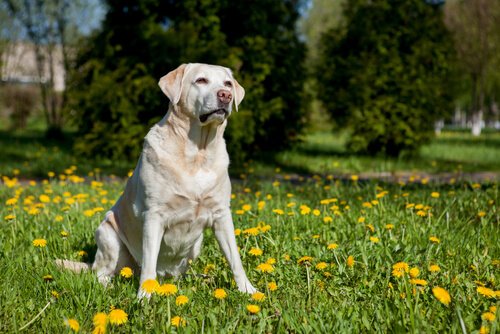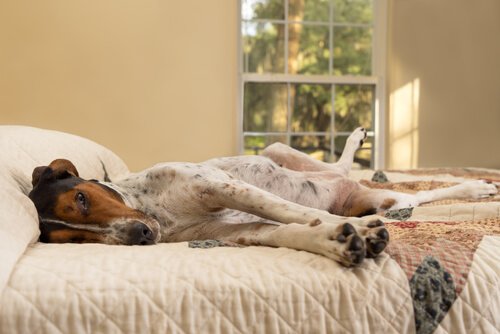6 Common Sleeping Positions for Dogs


Written and verified by the lawyer Francisco María García
Animals are built to sleep and rest in many different positions. While it is true that they tend to develop different habits and behaviors as they get older, there are quite a few common sleeping positions for dogs. In this article, we’re going to talk about six of them.
Lactating puppies always group together, and they do this to help retain body heat. The more flexible puppies will be the ones laying on their backs, or getting into other really funny positions.
As dogs get older, though, they are much more practical about it. The postures they adopt will be consistent with their mood, level of alertness, and the environmental circumstances.
A healthy dog will become more versatile with its body with the passage of time. He will assume all sorts of sleeping positions, many of them necessary for his survival and well-being.
The importance of letting dogs rest
The genes that dogs inherited from wolves makes them need to sleep very frequently, usually several times a day. Puppies can sleep up to 20 hours a day, while an adult dog will usually sleep around 13. As dogs get older, though, they often sleep as much as when they were puppies.
Adult dogs usually sleep about eight hours at night and take several much-needed naps during the day. When dogs sleep deeply enough, they drift into REM sleep, just like humans.

It’s important for dogs to have their own place to sleep, and for it to be a suitable one. That means it needs to be comfortable and the appropriate size. You must also take changes in the weather into account to prevent your pet from suffering from excessive temperatures.
Man’s best friend is a social beast. Dogs don’t like being alone, so they almost always look for their owners when it’s time to sleep or take a nap.
Obedience training for domestic animals, and especially dogs, is mainly about teaching them to assume certain bodily positions. For example, two of the very first commands a dog learns are to sit and lie down. Once a dog has learned these, you can go on to teaching him more complex commands.
This article lists and explains six common sleeping positions for dogs. Since there are dozens of dozens of positions to choose from, we are only discussing the most common ones.
Common resting and sleeping positions for dogs
Sitting down
In the classic sitting position, the dog’s front legs are stretched out in front of its body, and its rear legs are bent. In that way, the back of their perineum and their coxal bone are resting on the ground.
One variant is when the dog’s hind legs are more flexed and better supported. This makes it easy for them to leap up at a moment’s notice.

Lying on its sternum
A dog lying on its sternum reflects a certain level of alertness. In this position, the animal’s elbows and sternum are resting on the floor. In this position, they are able to alternate between lifting their head and neck up, or leaving their snout on the ground. This is a great position for dogs that want a short nap, while still having the ability to get up quickly.

There is also a variation where the dog’s legs are fully stretched out on the floor, meaning it lays on its stomach. Sometimes dogs adopt this position to cool off, but it is more common in puppies than adults.
Lying on its side
This is one of the most typical sleeping positions for dogs and consists of the animal laying on either one of its sides. This position will help animals rest their entire body, causing them to completely fall asleep. This is most likely to be one of the main positions in which your dog goes into REM sleep.

Lying sideways on its sternum
In this position, the dog’s front legs and sternum are stretched out on the floor or ground in front of him. Its back legs, however, rest on the lateral femur. This makes it possible for dogs to rest while continuing to remain alert.

Lying on its back
A dog lying on its back, with its legs open and its belly exposed, is usually doing it to cool off. This position is more common among puppies than adults.

Snuggled up
Dogs in this position tend to fall asleep easily, helping them achieve REM sleep. When we say “snuggled up”, we are talking about when a dog curls up in a little ball and brings its back legs up to its chin.

Although there are loads of other sleeping positions for dogs, these are some of the most popular ones. But similarly to humans, all dogs have their own peculiar personalities, and this can affect the sleeping positions they adopt.
However, it is absolutely possible to train your dog to assume these positions on command. If you are not sure whether you are up to the challenge, you can also hire a professional trainer to help you out.
Animals are built to sleep and rest in many different positions. While it is true that they tend to develop different habits and behaviors as they get older, there are quite a few common sleeping positions for dogs. In this article, we’re going to talk about six of them.
Lactating puppies always group together, and they do this to help retain body heat. The more flexible puppies will be the ones laying on their backs, or getting into other really funny positions.
As dogs get older, though, they are much more practical about it. The postures they adopt will be consistent with their mood, level of alertness, and the environmental circumstances.
A healthy dog will become more versatile with its body with the passage of time. He will assume all sorts of sleeping positions, many of them necessary for his survival and well-being.
The importance of letting dogs rest
The genes that dogs inherited from wolves makes them need to sleep very frequently, usually several times a day. Puppies can sleep up to 20 hours a day, while an adult dog will usually sleep around 13. As dogs get older, though, they often sleep as much as when they were puppies.
Adult dogs usually sleep about eight hours at night and take several much-needed naps during the day. When dogs sleep deeply enough, they drift into REM sleep, just like humans.

It’s important for dogs to have their own place to sleep, and for it to be a suitable one. That means it needs to be comfortable and the appropriate size. You must also take changes in the weather into account to prevent your pet from suffering from excessive temperatures.
Man’s best friend is a social beast. Dogs don’t like being alone, so they almost always look for their owners when it’s time to sleep or take a nap.
Obedience training for domestic animals, and especially dogs, is mainly about teaching them to assume certain bodily positions. For example, two of the very first commands a dog learns are to sit and lie down. Once a dog has learned these, you can go on to teaching him more complex commands.
This article lists and explains six common sleeping positions for dogs. Since there are dozens of dozens of positions to choose from, we are only discussing the most common ones.
Common resting and sleeping positions for dogs
Sitting down
In the classic sitting position, the dog’s front legs are stretched out in front of its body, and its rear legs are bent. In that way, the back of their perineum and their coxal bone are resting on the ground.
One variant is when the dog’s hind legs are more flexed and better supported. This makes it easy for them to leap up at a moment’s notice.

Lying on its sternum
A dog lying on its sternum reflects a certain level of alertness. In this position, the animal’s elbows and sternum are resting on the floor. In this position, they are able to alternate between lifting their head and neck up, or leaving their snout on the ground. This is a great position for dogs that want a short nap, while still having the ability to get up quickly.

There is also a variation where the dog’s legs are fully stretched out on the floor, meaning it lays on its stomach. Sometimes dogs adopt this position to cool off, but it is more common in puppies than adults.
Lying on its side
This is one of the most typical sleeping positions for dogs and consists of the animal laying on either one of its sides. This position will help animals rest their entire body, causing them to completely fall asleep. This is most likely to be one of the main positions in which your dog goes into REM sleep.

Lying sideways on its sternum
In this position, the dog’s front legs and sternum are stretched out on the floor or ground in front of him. Its back legs, however, rest on the lateral femur. This makes it possible for dogs to rest while continuing to remain alert.

Lying on its back
A dog lying on its back, with its legs open and its belly exposed, is usually doing it to cool off. This position is more common among puppies than adults.

Snuggled up
Dogs in this position tend to fall asleep easily, helping them achieve REM sleep. When we say “snuggled up”, we are talking about when a dog curls up in a little ball and brings its back legs up to its chin.

Although there are loads of other sleeping positions for dogs, these are some of the most popular ones. But similarly to humans, all dogs have their own peculiar personalities, and this can affect the sleeping positions they adopt.
However, it is absolutely possible to train your dog to assume these positions on command. If you are not sure whether you are up to the challenge, you can also hire a professional trainer to help you out.
This text is provided for informational purposes only and does not replace consultation with a professional. If in doubt, consult your specialist.








